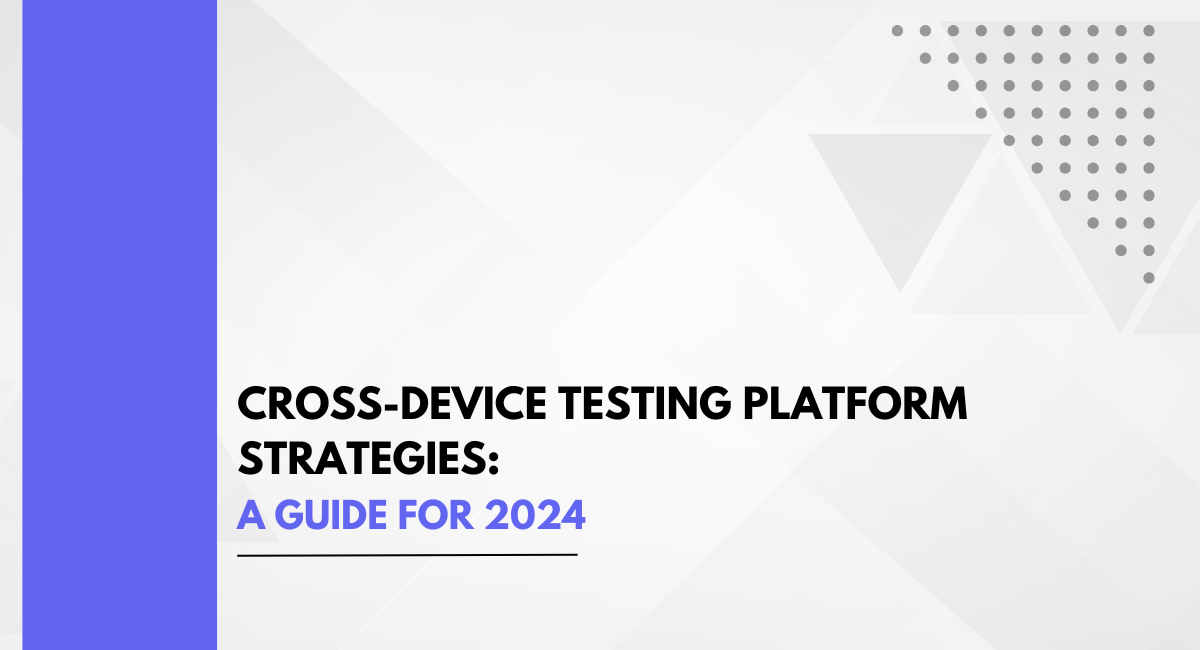In today's digital landscape, where devices and operating systems are as diverse as ever, ensuring that your application functions flawlessly across multiple platforms is no longer a nicety—it's a necessity. The proliferation of smartphones, tablets, and various operating systems like Android and iOS has made cross-device testing an indispensable step in software development. Read our Cross Device Testing Platform strategies guide.
The Importance of Cross-Device Testing
Cross-device testing involves evaluating how your application or website performs on different devices, including smartphones, tablets, laptops, desktops, and even smart TVs. This approach ensures that users have a consistent and positive experience regardless of their device. For instance, a website optimized for mobile devices will load quickly and provide an intuitive interface for smartphone users. Similarly, a desktop version should be visually appealing and easy to navigate for those on larger screens.
The failure to perform adequate cross-device testing can result in a myriad of issues. Users may encounter broken links, slow load times, or even worse—crashes. These problems can lead to frustration and low user engagement, ultimately affecting your brand's reputation and bottom line.
Key Aspects of Cross-Device Testing
User Experience (UX) Testing:
- UX testing is crucial for ensuring that your application or website meets the expectations of users. This involves conducting user testing sessions where participants interact with your product on various devices. Tools like Functionize provide comprehensive tools for cross-browser and cross-device testing, ensuring that UX issues are addressed .
Performance Optimization:
- Performance is a critical factor in cross-device testing. Slow load times can deter users from engaging with your product. Techniques like optimizing images, using content delivery networks (CDNs), and minimizing code can significantly improve performance across devices.
Accessibility:
- Accessibility is not just about complying with regulations; it's also about providing an inclusive experience for all users. Ensuring that your application or website is accessible on assistive devices like screen readers is essential .
Automation:
- Automation plays a significant role in cross-device testing by allowing developers to run tests repeatedly without manual intervention. Platforms like LambdaTest offer automation capabilities that help streamline the testing process .
Implementing Cross-Device Testing Strategies
Implementing effective cross-device testing strategies requires a well-structured approach:
Use a Cross Device Testing Platform:
- Utilize specialized platforms designed for cross-device testing such as TestRigor and LambdaTest. These tools provide comprehensive features for automating tests, analyzing performance metrics, and identifying bugs (Sources:,).
Create Detailed Test Plans:
- Develop clear test plans that outline the devices, browsers, and scenarios to be tested. This helps ensure that all potential issues are covered during the testing process.
Conduct Regular Testing Cycles:
- Regular testing cycles are essential for maintaining high-quality performance across devices. Schedule regular testing sessions to catch any issues that might arise from updates or changes to your application or website.
Collaborate with Stakeholders:
- Cross-device testing is not just a technical task; it requires collaboration between developers, designers, and stakeholders. Ensure that all parties are aligned with the testing goals and objectives.
Utilizing Advanced Technologies
In 2024, the tools and strategies for cross-device testing have advanced significantly. Automation capabilities, powered by AI and machine learning, are now integral to optimizing test processes, enhancing accuracy, and predicting potential issues . Cloud-based platforms offer scalable testing environments that support an array of browser and OS combinations, making it easier to manage the complexities of device variability .
Cloud-Based Testing Environments
Cloud-based testing environments provide scalable and cost-effective solutions for testing applications across a wide range of devices and virtual environments. Platforms like LambdaTest and Perfecto offer access to a variety of mobile devices, browsers, and operating system versions. These tools include advanced features like AI-driven analytics to identify and fix defects efficiently .
Integrating with CI/CD Pipelines
Integrating cross-device testing tools with CI/CD pipelines allows for continuous verification of application functionality as new code is deployed. This ensures that cross-browser and cross-device tests are executed consistently with each code change, providing fast feedback on application compatibility and stability .
Cross-device testing is no longer an optional feature; it's a necessary component of any successful digital strategy. By identifying bugs early, planning thoroughly, and implementing effective testing strategies using specialized platforms, you can ensure that your application or website provides a seamless experience across all devices. As technology continues to evolve at an unprecedented pace, staying ahead of the curve in cross-device testing will be crucial for maintaining user trust and engagement.
Tools for Cross-Device Testing
Several tools are available to streamline the cross-device testing process:
- TestRigor: Offers comprehensive frameworks for identifying and fixing bugs across different browsers and devices .
- LambdaTest: Provides dynamic, interactive testing on over 3,000 devices, offering advanced analytics tools to track performance metrics across different devices .
- Perfecto: Supports automated testing within DevOps cycles by offering access to a variety of mobile devices, browsers, and operating system versions .
By embracing these strategies and tools available today, you can guarantee that your product remains user-friendly and effective regardless of the device your audience uses.
Future Outlook
As technology continues to evolve rapidly, the importance of cross-device testing will only continue to grow. The integration of AI-driven automation tools with cloud-based testing environments will further streamline the testing process. Ensuring that your application functions seamlessly across a myriad of devices will be more crucial than ever.
By adopting a strategic mindset that prioritizes automation, real-time collaboration, and advanced analytics, developers can ensure that their applications deliver a consistent and optimized user experience across all platforms.
You may also be interested in: Implement Smart Testing in Your Strategy | A Complete Guide
Book a Demo and experience ContextQA testing tool in action with a complimentary, no-obligation session tailored to your business needs.
We make it easy to get started with ContextQA tool: Start Free Trial.
